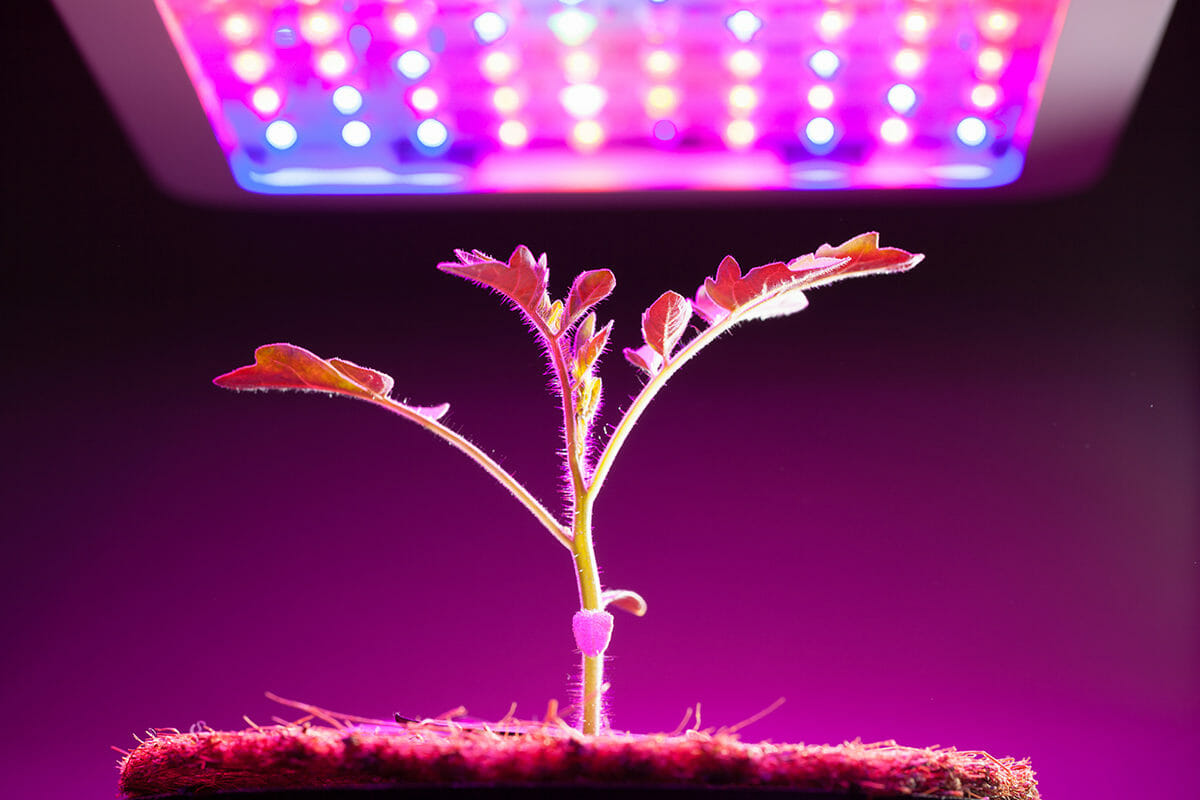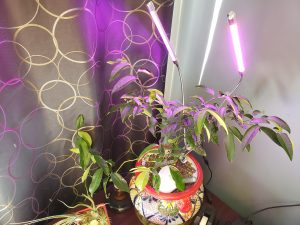Whether you’ve already got seedlings growing away or getting ready to start your annual indoor seed starting, one of the important factors in seed starting is light. (Last month I covered heat, which you can see here). Questions like “Do I need to use supplemental light or can I use a window?” and “What kind of light do I need to use?” are ones we often get from gardeners – new and seasoned alike. So I thought I’d take a little time to talk about light – the factors that are important for plant growth some ways that you can make sure you’re providing the right kinds and amounts of light to your new seedlings. Keeping these ideas in mind can help you choose lights for your seeds starting (or other plant needs), whether it is a simple shop light ballast from the hardware store, a pre-fab light cart system, or even higher-tech LED system.
Plants require light for several of their functions, most importantly the process of photosynthesis. The green pigments in plants (Chlorophyll A and B) act as receptors, gathering electrons from the light to use as an energy source to manufacture glucose, which is stored in the plant in a number of ways and then ultimately broken down in respiration to release energy to support plant functions. There are three aspects to light that gardeners should keep in mind for supplemental lighting: quality (color), quantity (brightness/intensity), and duration (day/night length).
Duration is a relatively simple concept when it comes to seeds starting and light set-ups. Gardeners will want to try to mimic the natural environment that will be provided by the sun. For the most part, aiming for 16 hours of light and 8 hours of dark is standard. This gives the plant sufficient light, but also provides a rest period which can be important for plant functions. Most gardeners find it handy to invest in timers to turn lights on and off, rather than trying to remember to do it themselves. This can be a simple on-off set up from the hardware store (after-holiday shopping can be a good way to pick them up on sale in the string light section) to something more elaborate from grower suppliers. Duration could be more important if you’re doing longer term growing beyond seeds starting, as day length affects initiating of flowering in some plants.
Intensity refers to how bright the lights are. Some lucky people have big windows with lots of bright light for starting seeds, but even for them intensity (and duration) may not be enough during the shorter, grayer days of winter. Growing in bright windows can sometimes be a challenge because the light is coming from the side rather than above, so plants often grow toward the window and need to be rotated. Supplemental light can increase intensity and lengthen duration, even for plants grown in windows.
Most commonly, light bulbs are sold by wattage as a measure of their energy (light) output. Standard tube florescent lights are generally around the 40 Watt level, but some of the full spectrum plant lights come in 54W options. If you can find it, the higher wattage can make a big difference in the intensity of light and thus the production of your plants. Even at the higher wattage, you’ll want to get a ballast that holds at least two bulbs (and some grow light ballasts hold more). You can further control the intensity of light reaching your plants by increasing or decreasing the distance between the plants and the lights. This is why the pre-made plant carts have a chain or other mechanism for you to raise and lower the lamps. For fluorescents, lights are sometimes lowered to around an inch above the canopy of the plants. For high intensity LEDs, the distance may need to be more. (If you’re using lights for long-term growth of, say houseplants, you’ll have to experiment with the distance to meet the intensity needs of the plants – closer for high light plants and farther away for low light plants).
Light Quality: The Rainbow Connection
Sunlight, or white light, is composed of all of the colors of the spectrum. Think back to art class and our friend ROY G BIV – the colors of the rainbow. There’s also parts of the spectrum that we don’t see like ultraviolet and infrared. For photosynthesis, plants mostly use light in the red and blue spectrum (referred to as Photosynthetic Active Radiation, or PAR), though almost all of the colors have some sort of effect or function on plants. Blue light has a role in promoting vegetative growth in plants, while red has a role in promoting flowering.

For most applications, supplemental light for seed starting or other indoor growing should be full-spectrum. You can achieve this in a variety of ways – buying specific full-spectrum plant light bulbs is the best, but you can buy non-plant specific full spectrum bulbs as well. For small-scale home growers and beginners, it can be as simple as buying a shop light ballast at the hardware/box store with a full spectrum bulb. For more intensive or large-scale growers, there are lots of sources for higher-end, full spectrum grow lights that you can buy from specialty garden retailers, but these are often more than what home gardeners starting seeds indoors need.
Fluorescent vs LED

These days you might be presented with a choice of lights – fluorescent vs. LED. There are some positives and negatives to each. While they have a higher up-front cost, LEDs use much less energy than fluorescents and can save money over several seasons of use. The reduced energy usage also means there’s less energy loss in the form of heat, which can be a positive if you are always struggling with creating excess heat that burns your plants, but a negative if you’re relying on that heat to help keep the temperatures up (see my article from last month on heat and seed starting) or have issues with drying out your growing media. Fluorescents on the other hand can be more affordable up-front, but have a higher energy usage that will result in higher electric bills over time.

You might have noticed in your searching or in visiting some growers that LED lights for plant growth come in either white (full spectrum) or a red/blue combination which end up giving a purple light. Since LEDs give a larger control over the spectrum of light, growers, especially larger scale intensive operations, use these red/blue combinations as a means to add further energy efficiency since it is the blue and red spectra that are the photosynthetic. By eliminating the spectra that are largely reflected rather than absorbed, less energy is used. This is useful in hydroponic and vertical farming systems where short-term crops are being grown quickly and where profit margins can be slim.
You can read (and listen to) more about light in the Joe Gardener podcast and article on seeds starting I was interviewed for last year with Joe Lamp’l.
However, research has emerged in the last few years that expanding the spectra of light in LED systems increases production. Research has shown that incorporating green LEDs significantly increases production over just red/blue LEDs (some of that research was by Kevin Folta, who is one of the leading science communicators on biotechnology). While green plants largely reflect rather than absorb green light, it does have some effect on plant functions. (Research also shows that adding the green makes the light appear a little more natural to workers in facilities like greenhouses and makes it easier to see issues with the plants – the purple of the red/blue systems washes out the plants and makes it hard to see differences in leaves like diseases).
So if you’re looking at LEDs for seeds starting, and especially if you’re looking at them for longer term indoor plant growing, stick with full spectrum or explore one of the LED systems that incorporates green. Though don’t be afraid to experiment with the colorful LED options – I have a small red/blue system to suppleme nt light to my office potted lime. The key is to experiment and shop around – every gardener’s need for supplemental light is different and the solutions to those needs are different. Don’t be afraid to start small with that shop light from the hardware store before working your way up – especially if you’re just starting a small amount of seeds in the spring.
nt light to my office potted lime. The key is to experiment and shop around – every gardener’s need for supplemental light is different and the solutions to those needs are different. Don’t be afraid to start small with that shop light from the hardware store before working your way up – especially if you’re just starting a small amount of seeds in the spring.
